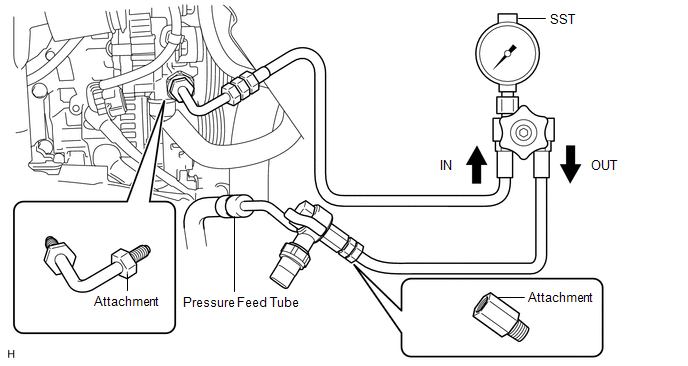ON-VEHICLE INSPECTION PROCEDURE 1. INSPECT DRIVE BELT
(b) Check by hand that the belt fits properly in the ribbed grooves and has not slipped out of the grooves on the bottom of the crank pulley. 2. BLEED POWER STEERING SYSTEM (a) Check the fluid level. (b) Jack up the front of the vehicle and support it with stands. (c) Turn the steering wheel. (1) With the engine stopped, turn the wheel slowly from lock to lock several times. (d) Lower the vehicle. (e) Start the engine. (f) Run the engine at idle for a few minutes. (g) Turn the steering wheel. (1) With the engine idling, turn the wheel left or right to the full lock position and keep it there for 2 to 3 seconds, then turn the wheel to the opposite full lock position and keep it there for 2 to 3 seconds.(*1) (2) Repeat (*1) several times. (h) Stop the engine.
(j) Check the fluid level. 3. CHECK FLUID LEVEL
(b) With the engine stopped, check the fluid level in the reservoir. If necessary, add fluid. Fluid: ATF DEXRON II or III, or equivalent HINT: If the fluid is hot, check that the fluid level is within the HOT range. If the fluid is cold, check that the fluid level is within the COLD range. (c) Start the engine and run it at idle. (d) Turn the steering wheel from lock to lock several times to raise the fluid temperature. Fluid temperature: 80°C (176°F)
(g) Stop the engine. (h) Wait a few minutes and remeasure the fluid level in the reservoir. Maximum fluid level rise: 5.0 mm (0.197 in.) If the fluid level rise is more than the maximum, bleed the power steering system. (i) Check the fluid level. 4. CHECK STEERING FLUID PRESSURE (a) Disconnect the pressure feed tube from the vane pump (See page
(b) Connect SST as shown in the illustration. SST: 09640-10010 09641-01010 09641-01030 09641-01060 NOTICE: Make sure that the valve of SST is in the open position. (c) Bleed the power steering system. (d) Start the engine and run it at idle. (e) Turn the steering wheel from lock to lock several times to raise fluid temperature. Fluid temperature: 80°C (176°F) 
(h) Measure the fluid pressure at engine speeds of 1000 rpm and 3000 rpm. Difference in fluid pressure: 490 kPa (5.0 kgf/cm2, 71 psi) or less NOTICE: Do not turn the steering wheel. If the pressure difference is above the specified range, check for fluid leaks and replace parts as necessary.
(j) Disconnect SST. SST: 09640-10010 09641-01010 09641-01030 09641-01060 (k) Connect the pressure feed tube (See page
(l) Bleed the power steering system. |
Toyota Tundra Service Manual > Dynamic Radar Cruise Control System: Cruise Main Indicator Light Circuit
DESCRIPTION When the dynamic radar cruise control system is turned on using the cruise control main switch (ON-OFF button), the cruise control indicator (vehicle-to-vehicle distance control mode) illuminates. The ECM uses this and other indicators to indicate the control condition (presence or absen ...